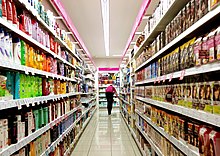Fast-moving consumer goods
This article needs additional citations for verification. (August 2018) |



Fast-moving consumer goods (FMCG), also known as consumer packaged goods (CPG)[1] or convenience goods, are products that are sold quickly and at a relatively low cost. Examples include non-durable household goods such as packaged foods, beverages, toiletries, candies, cosmetics, over-the-counter drugs, dry goods, and other consumables.[2][3][4]
Fast-moving consumer goods have a high inventory turnover and are contrasted with specialty items, which have lower sales and higher carrying charges. Many retailers carry only FMCGs, particularly hypermarkets, big box stores, and warehouse club stores. Small convenience stores also stock fast-moving goods; the limited shelf space is filled with higher-turnover items.
Characteristics
[edit]The following are the main characteristics of FMCGs:[2]
- From the consumer perspective
- Frequent purchases
- Low engagement (little or no effort to choose the item)
- Low prices
- Short shelf life
- Rapid consumption
- From the marketer perspective
- High volumes
- Low contribution margins
- Extensive distribution
- High inventory turnover
Shelf space
[edit]Between 2009 and 2023, shelf space in the U.S. supercenters and supermarkets decreased by 5 and 3.3 percent, respectively. This reduction has intensified competition for shelf space among brands, as the number of products available has increased. Retailers often charge slotting fees to brands for product placement. While some well-established brands may avoid these fees, the average cost can range from $100 per item per store to significantly higher amounts.[5]
Consumer packaged goods companies
[edit]Well-known CPG manufacturing companies include:[6]
- Nestlé
- Procter & Gamble
- Essity
- PepsiCo
- Unilever
- AB InBev
- L’Oréal
- Coca-Cola
- Mondelez International
- Mars Wrigley
- Kraft Heinz
- Heineken
- Kellogg's
Rural consumers
[edit]Consumers in rural areas typically purchase goods from nearby towns and villages. A recent[when?] shift in consumer purchase behavior toward purchasing locally has prompted the need for better local promotional efforts to generate brand awareness in small towns. FMCGs play a large part in the economy, as they are inelastic products that touch every part of consumer life. Businesses that supply FMCGs to rural communities can help provide employment opportunities and reduce the cost of such products in those rural areas. For instance, FMCGs represent the fourth-largest sector in the Indian economy[7] and generate employment for more than three million people in downstream activities.[8]
ISIC definition
[edit]The retail market for FMCGs includes businesses in the following International Standard Industrial Classification (ISIC) (Revision 3) categories:[9]
- ISIC 5211 retail sales in non-specialized stores
- ISIC 5219 other retail sales in non-specialized stores
- ISIC 5220 retail sales of food, beverages, and tobacco in specialized stores
- ISIC 5231 retail sales of pharmaceutical and medical goods, cosmetic and toilet articles
- ISIC 5251 retail sales via mail-order houses
- ISIC 5252 retail sales via stalls and markets
- ISIC 5259 wholesale goods
- ISIC 5269 wholesale medical prescriptions
Supplier industries for FMCGs include:
- 1511 meat and meat products
- 1512 fish and fish products
- 1513 fruit and vegetables
- 1514 vegetable and animal oils and fats
- 1520 dairy products
- 1531 grain mill products
- 1532 starches and starch products
- 1533 animal feeds
- 1541 bakery products
- 1542 sugar
- 1543 cocoa, chocolate, and sugar confectionery
- 1544 macaroni, noodles, couscous
- 1549 other food products
- 1551 spirits, ethyl alcohol
- 1552 wines
- 1553 malt liquors and malt
- 1554 soft drinks, mineral waters
- 1600 tobacco products
- 2101 pulp, paper and paperboard
- 2102 corrugated paper containers
- 2109 other articles of paper and paperboard
- 2424 soap and detergents, cleaning preparations, perfumes
- 2430 men's and women's inner garments, shaving gels, deodorants, personal care, home care
See also
[edit]References
[edit]- ^ "Consumer Goods Industry News, Research & Events". Consumer Goods Technology. Retrieved 2024-10-21.
- ^ a b Ramanuj Majumdar (2004). Product Management in India. PHI Learning. pp. 26–27. ISBN 978-81-203-1252-4. Archived from the original on 2023-07-01. Retrieved 2010-06-19.
- ^ Sean Brierley (2002). The Advertising Handbook (2nd, illustrated ed.). Routledge. p. 14. ISBN 978-0-415-24391-9.
- ^ Nellist, George (2022-10-06). "By looking to nature, health products manufacturer Melaleuca is breaking barriers". Digital Journal. Archived from the original on 2022-10-09. Retrieved 2022-10-09.
- ^ Williams, Jennifer (2024-08-14). "'Stress on Shelves'—the Battle for Space in Store Aisles". The Wall Street Journal. Retrieved 2024-08-15.
- ^ Jesse; Jesse (2020-04-30). "Top 10 Largest CPG Companies by Revenue in the World 2020 | CPG Industry Factsheet". Bizvibe Blog. Archived from the original on 2022-10-09. Retrieved 2022-10-09.
- ^ "Indian FMCG Industry Analysis". www.ibef.org. Archived from the original on 2020-02-25. Retrieved 2020-02-25.
- ^ Singaravelu, Dr. K. (October 2013). "Rural Consumer Behaviour on Fast Moving Consumer Goods" (PDF). Archived (PDF) from the original on 2018-10-08. Retrieved 2018-10-07.
- ^ Aydın Çelen; Tarkan Erdoğan; Erol Taymaz (June 2005). "Fast Moving Consumer Goods Competitive Conditions and Policies" (PDF). Economic Research Center, Middle East Technical University. Archived from the original (PDF) on 2017-12-15. Retrieved 2007-07-09., p.2-4
